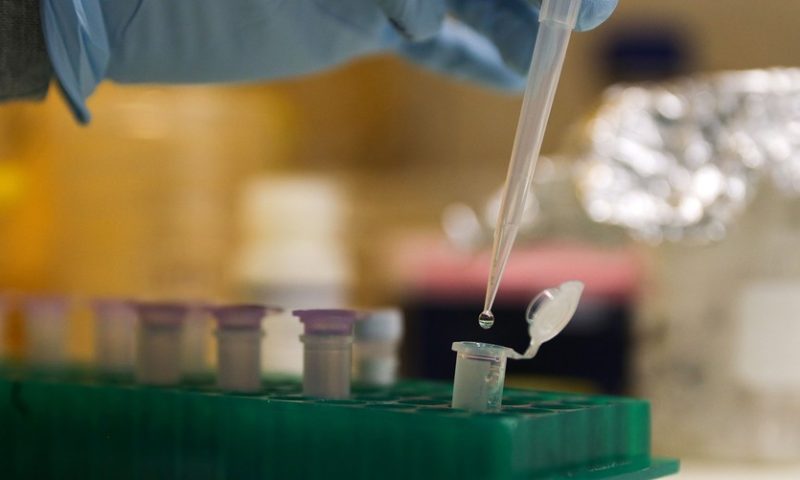The company played up certain results, but investors focused on the weak spots
Sangamo Therapeutics Inc. stock dropped 23.6% in extremely active Wednesday trade after the company released early results from a gene-editing trial for a rare metabolic disorder called Hunter syndrome. Shares continued their fall on Thursday, dropping 4.6%.
The trial marked the first instance of gene editing, or adding a new copy of a gene into the DNA of a patient’s cells, completed inside the body, or in vivo, Sangamo SGMO, +5.36% said. In other types of gene editing and gene therapies that have been tested or approved in the U.S., the process is completed outside of the body.
Two patients in the Sangamo trial had reductions of a key biomarker called urinary glycosaminoglycans (GAGs) after 16 weeks of treatment. Because of the enzyme deficiency that individuals with Hunter syndrome have, GAGs tend to accumulate in the body.
But the company said that it wasn’t able to measure changes in the missing enzyme, called iduronate-2-sulfatase (IDS), 16 weeks after treatment, because its activity in plasma “was below the level of quantification of the current assay.”
Sangamo sought to play up the changes in GAGs seen in the trial, and described results as encouraging. But the company also admitted that it could not yet say whether the gene-editing candidate, SB-913, could replace the enzyme replacement therapy that is currently used to manage Hunter syndrome’s symptoms.
“We want to see GAGs that are reduced and remain reduced when the patient withdraws enzyme replacement therapy,” a company executive said on a Wednesday conference call. “I think if the patient had to take our medicine and enzyme replacement on top of it, it’s a less attractive proposition.”
Hunter syndrome, also called MPS II, primarily affects boys and causes progressive cell damage. A very rare disease, it affects about 500 patients in the U.S., according to Sangamo.
Sangamo’s “zinc finger nuclease” gene-editing technique, which is named after the zinc finger proteins that bind to DNA, aims to treat Hunter syndrome by adding a new copy of a gene into the DNA of a patient’s liver cells. The goal is to produce “a continuous and stable supply of the missing human IDS enzyme,” the company said.
The phase 1/2 trial, called “Champions,” enrolled six patients total, divided into three groups that ranged from low to mid and high doses of SB-913. SB-913 was generally well-tolerated, according to Sangamo; though two serious side effects were seen, the investigator decided they were primarily related to the disease and not the treatment.
Sangamo emphasized the results for two patients on a mid dose of the therapy. Enrollment and dosing of patients in the high-dose cohort was just completed, the company said, with results expected in the next few months.
Although the stock fell on Wednesday, not everybody was skeptical of the results. Jason Tauber, co-portfolio manager of the Neuberger Berman Disrupters All-Cap Growth Portfolio — which has a stake in Sangamo — continues to be confident in the company and its technology.
“When I think about why are people unhappy today relative to the run-up into the data: ultimately, they’re inserting a gene into the liver cells that will result in the production of this enzyme, and we can’t see it,” Tauber said. But, at the same time, “it’s hard to see why else GAGs in the urine would be reduced so much if the enzyme wasn’t being produced.”
Tauber also pointed to the number of clinical data readouts that Sangamo has coming up in the next several months, as well as its innovative gene-editing technology.
“The reality is that this company has a lot of shots on goal,” he said, adding that zinc finger nuclease technology “may ultimately prove to be superior to CRISPR,” referring to another cutting-edge gene editing technique.
The company also suggested on Wednesday that results for GAGs could be enough on its own, describing the measure as what got Elaprase, Shire’s SHPG, -1.05% enzyme replacement therapy for Hunter syndrome, approved.
Elaprase does target GAG, and decreases in urinary GAG levels were seen after treatment, but the therapy’s primary outcome in trials was that it improved walking capacity in patients, according to its prescribing information.
Sangamo also said on Wednesday that it has also developed new versions of the gene editing technique that could be several times more effective, so “even if cohort three isn’t effective, there’s other places we can go,” an executive said on the Wednesday call.
The company is also developing programs for hemophilia A and B, MPS I, beta thalassemia and more. Of those, its hemophilia B program uses the same approach, or zinc finger nuclease genome editing.
The stock has dropped 16% over the last three months, compared with a 4% rise in the S&P 500 SPX, -0.22% and a 3.4% rise in the Dow Jones Industrial Average DJIA, -0.31% .

